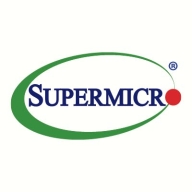

HPE BladeSystem and Supermicro SuperBlade are competitive products in the modular server market. Supermicro SuperBlade seems to have the upper hand with advanced features, whereas HPE BladeSystem offers better pricing and support, appealing to budget-conscious buyers.
Features: HPE BladeSystem provides seamless integration, scalability, and robust management capabilities, which are beneficial for enterprise environments. Supermicro SuperBlade focuses on high-density computing, enhanced performance features, and efficient use of resources, making it ideal for high-demand applications.
Room for Improvement: HPE BladeSystem could improve by enhancing performance features, reducing complexity in network integration, and expanding high-demand capabilities. Supermicro SuperBlade could benefit from simplifying its management interface, better documentation for ease of deployment, and reducing compatibility issues with different software environments.
Ease of Deployment and Customer Service: HPE BladeSystem is known for easy integration and efficient customer service, enabling smoother deployment. Supermicro SuperBlade, while requiring a learning curve, offers strong post-deployment support.
Pricing and ROI: HPE BladeSystem is noted for competitive setup costs, offering solid long-term ROI. Supermicro SuperBlade requires a higher initial investment but delivers significant returns through efficient task handling.


HP ProLiant BladeSystem share power, cooling, network, and storage infrastructure via the blade enclosure. Since equipment is not needed for each server, you get a dramatic reduction in power distribution units, power cables, LAN and SAN switches, connectors, adapters, and cables. And you can add the newest-generation technologies by simply changing individual components.
Supermicro SuperBlade delivers innovative computing performance and efficiency, perfect for data-intensive tasks. With its modular design, it optimizes space and power, providing a flexible and scalable infrastructure for demanding business workloads.
Supermicro SuperBlade is specifically engineered for modern data centers needing high-density computing. It offers a compact, modular architecture that simplifies system management and enhances agility. It integrates seamlessly with cloud and virtualization technologies, supporting diverse applications and workloads. Its design focuses on reducing operational costs while achieving peak performance. Users appreciate its balance of power efficiency and high computing capacity.
What are the key features of Supermicro SuperBlade?Supermicro SuperBlade is widely implemented in sectors such as finance, healthcare, and research where high computational power and storage are critical. In finance, it's used for real-time analytics and transactions. Healthcare facilities use it for patient data analysis and complex simulations, while research institutions leverage SuperBlade for simulations and data-intensive research tasks. Its adaptability allows enterprises to efficiently meet technical requirements unique to each industry.
We monitor all Blade Servers reviews to prevent fraudulent reviews and keep review quality high. We do not post reviews by company employees or direct competitors. We validate each review for authenticity via cross-reference with LinkedIn, and personal follow-up with the reviewer when necessary.